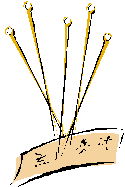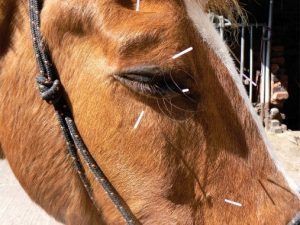
This will be our first posting of a regular series on acupuncture. The newest member of our team at MVS, Dr. Marie Bartling, is certified in acupuncture and will be authoring this series designed to educate our clients on the uses of acupuncture, how it works, and how it can be beneficial to your horse.
 Acupuncture Case Study: Facial Paralysis
Acupuncture Case Study: Facial Paralysis
Over time we have come to understand that living things function through body systems that are ultimately controlled on a cellular level. This means that the mechanism of function is so small and so vast that the communication between cells, and ultimately our body function, is mind-blowing.
There are three basic ways a body is governed; electrically, chemically, and mechanically. The body systems that do the governing are: the nervous system, the cardiovascular system, and the musculoskeletal system.
Acupuncture affects the body by altering the cellular communication between the brain, spinal cord, and peripheral nerves. For example, movement is a complex chemical process that begins at the level of sensation. A horse perceives it is standing on a surface, and the nature of communication between cells dictates how the horse moves in relationship to its needs and environment.
Facial paralysis is a common ailment of horses that have experienced a head injury that results in damage to the nerves, or swelling around the facial nerves just under the skin on the horses face. Depending on the location of facial nerve damage, a horse may have a droopy ear, eye, and nose on that side.
Nerves transmit information and stimulate movement via sodium and calcium which are electrically charged ions within the nerve. In some cases, a TENS (transcutaneous electrical nerve stimulation) unit may be used to facilitate this process in muscles and nerves that are not working properly by sending electrical impulses to pinpointed parts of the body through the acupuncture needles.
The picture below is of an Arabian horse with allergies. She becomes itchy in the spring and damaged herself by rubbing her head on the barn door. In this picture her lip is droopy, her eyelid is swollen and the eye itself was scratched, leading to a corneal ulcer.

Acupuncture points are selected based on the location of the affected nerve, the skin area it provides function to, and traditional Chinese points that provide relief from the “Wind Heat” of the allergic state and stimulate regulation of the immune system.
Needles were used around the eye to reduce swelling, and needles were used on her nose and facial muscles in combination with a TENS unit to help encourage normal chemical and electrical stimulation of the muscles on her face.
The ulcer on the surface of her eye was treated with topical antibiotics several times daily until it healed. She recovered well, and is now managed for spring allergies.
Next in our Acupuncture series: Acupuncture and Allergies. Stay tuned!






No comment yet, add your voice below!